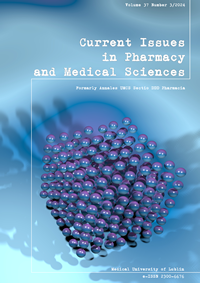The effect of ethyl acetate extract from Atractylis flava Desf. on the gene expression of pro-inflammatory cytokines and oxidative stress markers in NR8383 alveolar rat macrophage cells
DOI:
https://doi.org/10.2478/cipms-2024-0022Keywords:
Atractylis flava Desf, NR8383, NF-κB, TNF-α, IL-1β, IL-6, NCF1, OPA1, SDHAAbstract
Atractylis flava Desf. (AF) is common plant that is widely used for its anti- inflammatory and antioxidant properties. The purpose of this study was, therefore, to evaluate the cytotoxic effect and the molecular basis of antioxidant and anti-inflammatory effects of the ethyl acetate extract (AFEAE) obtained from the whole plant A. flava. This was accomplished through the use of NR8383 alveolar rat macrophage cells. Cultures of alveolar rat macrophage cells were treated with AFEAE (25–800 μg/mL), and cell viability was determined via WST-1 and LDH tests. In turn, the gene expression levels of nuclear factor κB (NF-κB), tumor necrosis factor-alpha (TNFα), interleukin 1 beta (IL1-β), interleukin 6 (IL-6), mitochondrial dynamin like GTPase (OPA1), Succinate dehydrogenase complex subunit A (SDHA) and neutrophil cytosolic factor 1 (NCF1) were assessed by applying RT-qPCR. The results show that ethyl acetate extracts of A. flava have non-cytotoxic effects, and the gene expression analysis demonstrates that AFEAF extracts generate significant downregulation of NF-κB, TNFα, IL-1 β, IL-6, NCF1, OPA1 and SDHA, compared to untreated cells. This study reveals that Atractylis flava ethyl acetate extract administration may be considered as a potential therapeutic strategy for inflammatory related diseases.
References
1. Akram MM, Naima B, Marref SE, Joubert O, Doumandji ZM, Safar R. Gene expression levels of selected factors in monocytic leukemia cell line THP-1 upon treatment with n-butanol extract of atractylis flava desf against cancer. J Young Pharm. 2019;11(1):36.
2. Shen DN, Zhang LH, Wei EQ, Yang Y. Autophagy in synaptic development, function, and pathology. Neurosci Bull. 2015; 31:416–26.
3. Chabani S, Lavaud C, Benkhaled M, Harakat D, Long C, Haba H. Three new oleanane-type triterpene saponins from Atractylis flava. Phytochem Lett. 2016;15:88-93.
4. Chabani S, Lavaud C, Benkhaled M, Harakat D. Flavonoid glycosides and triterpenoids from Atractylis flava. Phytochem Lett. 2013;6(1):9-13.
5. Badgujar SB , Patel VV, Bandivdekar AH, Mahajan RT. Traditional uses, phytochemistry and pharmacology of Ficus carica: a review. Pharm Biol. 2014;52:1487-503.
6. Nahle S, Safar R, Grandemange S, Foliguet B, Lovera-Leroux M, Doumandji Z, et al. Single wall and multiwall carbon nanotubes induce different toxicological responses in rat alveolar macrophages. J Appl Toxicol. 2019
7. Ronzani C, Safar R, Diab R, Chevrier J, Paoli J, Abdel-Wahhab MA, et al. Viability and gene expression responses to polymeric nanoparticles in human and rat cells. Cell Biol Toxicol. 2014; 30:137-46.
8. Eidi H, Joubert O, Némos C, Grandemange S, Mograbi B, Foliguet B, et al. Drug delivery by polymeric nanoparticles induces autophagy in macrophages. Int J Pharm. 2012;422:495-503.
9. Dos Santos M, Chen G, Almeida M, Soares D, De Souz G, Lopes N, et al. Effects of caffeoylquinic acid derivatives and C-flavonoid from Lychnophorericoides on in vitro inflammatory Mediator production. Nat Prod Commun. 2010;5(5);733-40.
10. Melo G, Muzitano M, Legora-Machad A, Almeida T, Oliveira D, Kaiser C, et al. C-glycosylflavones from the aerial parts of Eleusineindica inhibit LPS induced mouse lung inflammation. Planta Medica. 2005;71(4):362-3.
11. Akram MM, Naima B, Eddine MS, Soumia B. Anti-Inflammatory, Antipyretic and Acute Toxicity Effects of n-Butanol Extract of Atractylis flava Desf in Rats. Pharmacog J. 2018;10(4):763-7.
12. Melakhessou MA, Benkik N, Marref SE. Determination of antioxidant capacity, flavonoids and total phenolic content of extracts from Atractylis flava Desf. Res J Pharm Tech. 11(12):5221–5226.
13. Melakhessou MA, Marref SE, Benkiki N, Marref C, Becheker I, Khatabbi L. In vitro, acute and subchronic evaluation of the antidiabetic activity of Atractylis flava Desf n-butanol extract in alloxan-diabetic rats. Futur J Pharm Sci. 2021;7:206.
14. Dvorakova M, Landa P. Anti-inflammatory activity of natural stilbenoids: A review. Pharmacol Res. 124:126-145.
15. Hussain SP, Harris CC. Inflammation and cancer: an ancient link with novel potentials. Int J Cancer. 2017;121,2373-80.
16. Federico A, Morgillo F, Tuccillo C, Ciardiello F, Loguercio C. Chronic inflammation and oxidative stress in human carcinogenesis. Int J Cancer. 2007;121: 2381-6.
17. López-Armada MJ, Riveiro-Naveira RR, Vaamonde-García C, Valcárcel-Ares MN. Mitochondrial dysfunction and the inflammatory response. Mitochondrion. 2013;13(2):106-18.
18. Gumeni S, Evangelakou Z, Tsakiri EN, Scorrano L, Trougako IP. Functional wiring of proteostatic and mitostatic modules ensures transient organismal survival during imbalanced mitochondrial dynamics. Redox Biol. 2019;24:101219.
19. Shad AA, Ahmad S, Ullah R, AbdEl-Salam NM, Fouad H, Ur Rehman N, et al. Phytochemical and biological activities of four wild medicinal plants. Sci World J. 2014:857363.
20. Müller-Rischart AK, Pilsl A, Beaudette P, Patra M, Hadian K, Funke M, et al. The E3 ligase parkin maintains mitochondrial integrity by increasing linear ubiquitination of NEMO. Mol Cell. 2013;49:908-21.
Downloads
Published
Issue
Section
License
Copyright (c) 2024 Authors

This work is licensed under a Creative Commons Attribution-NonCommercial-NoDerivatives 3.0 Unported License.


